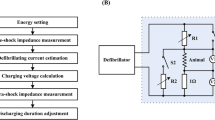Abstract
The term defibrillation threshold is usually understood to mean the shock intensity just enough to defibrillate a specified cardiac chamber (atria or ventricles). With the advent of so many different types of defibrillator, it is important to be able to specify the defibrillation threshold, which has frequently been described by the classical strength-duration curve. Another method of representing defibrillation plots the percent-successful defibrillation against shock-strength area. The mechanism of defibrillation is discussed, and the concepts of the strength-duration curve and percent-success against shock-strength curves are compared. Because defibrillation is associated with a time-varying spectrum of cellular excitability, a given shock strength will not always achieve defibrillation, and this produces the sigmoid shape for the curve that relates percent-successful defibrillation to shock strength. Therefore it is important to recognise two concepts: first, there is a family of strength-duration curves for defibrillation, each curve representing a given percent-successful defibrillation, and, secondly, there is a family of percent-success against shock-strength curves, one for each pulse duration. Canine ventricular defibrillation data are used to bring these two concepts together. Most importantly, the concepts adduced in the paper apply to transventricular, intracardiac and transchest defibrillation; the only difference in these applications is a scale factor that represents electrode location with respect to the heart.
Similar content being viewed by others
References
Babbs, C. F., Tacker, W. A., Van Vleet, J. F.,et al. (1980): ‘Therapeutic indices for transchest defibrillator shocks, effective, damaging and lethal doses’.Am. Heart J.,99, pp. 734–738
Bourland, J. D., Tacker, W. A. andGeddes, L. A. (1978): ‘Strength-duration curves for trapezoidal waveforms of various tilts for transchest defibrillation in animals’.Med. Instr.,12, (1), pp. 38–41
Geddes, L. A. andTacker, W. A. (1971): ‘Engineering and physiological considerations of direct capacitor-discharge ventricular defibrillation’.Med. Biol. Eng.,9, pp. 185–199
Geddes, L. A., Tacker, W. A., Rosborough, J.,et al. (1974a): ‘The electrical dose for ventricular defibrillation with electrodes applied directly to the heart’.Thor. Cardiovasc. Surg.,68, (4), pp. 593–605
Geddes, L. A., Tacker, W. A., Rosborough, J.,et al. (1974b): ‘Electrical dose for ventricular defibrillation of large and small animals using precordial electrodes’.Clin. Invest.,53, (1), pp. 310–319
Geddes, L. A. andBourland, J. D. (1985): ‘The strength-duration curve’.IEEE Trans.,BME-32, (6), pp. 458–459
Hoorweg, J. L. (1982): ‘Ueber die elektrische Nerveneregung’.Arch. Physiol.,52, pp. 87–109
Ideker, R. E., Wolf, P. D. andTang, A. S. L. (1994): ‘Mechanisms of defibrillation’ inTacker, W. A. (Ed.): ‘Defibrillation of the heart’ (Mosby, St. Louis)
Koning, G., Schneider, H. andHoelen, A. A. J. (1975): ‘Amplitude-duration relation for direct ventricular defibrilation with rectangular current pulses’.Med. Biol. Eng. Comput.,May, pp. 388–395
Lapicque, L. (1909): ‘L'excitabilite en fonction du temps’ (Presses Universitaires de France, Paris) p. 371 (also Libraire Gilbert, 1926)
McWilliam, J. A. (1887): ‘Fibrillar contractions of the heart’.J. Physiol.,8, pp. 296–310
Mirowski, M., Mower, M. M., Staeven,et al. (1970): ‘Standby automatic defibrillator’.Arch. Intern. Med., pp. 126–158.
Mirowski, M., Reid, P. R., Mower, M.et al. (1980): ‘Termination of malignant ventricular arrhythmias with an implanted automatic defribillator in human beings’.New Eng. J. Med.,Aug, pp 322–324
Niebauer, M. D., Babbs, C. F. andGeddes, L. A. (1983): ‘Efficacy and safety of defibrillation with rectangular waves 2–20 milliseconds duration’.Crit. Care Med.,11, (2), pp. 95–98
Schuder, J., Stoeckle, H. andDolan, A. N. (1964): ‘Transthoracic ventricular defibrillation with square-wave stimuli’.Circ. Res.,15, pp. 258–264
Weiss, G. (1901): ‘Sur la possibilite de rendre comparables entre eux les apareils servant a l'excitation’.Arch. Ital. Biol.,35, pp. 413–446
Zipes, D. P. (1975): ‘Termination of ventricular fibrillation in dogs by depolarising a critical amount of myocardium’.Am. J. Cardiol.,36, pp. 37–44
Author information
Authors and Affiliations
Rights and permissions
About this article
Cite this article
Geddes, L.A., Tacker, W.A., Babbs, C.F. et al. Ventricular defibrillating threshold: strength-duration and percent-success curves. Med. Biol. Eng. Comput. 35, 301–305 (1997). https://doi.org/10.1007/BF02534080
Received:
Accepted:
Issue Date:
DOI: https://doi.org/10.1007/BF02534080




